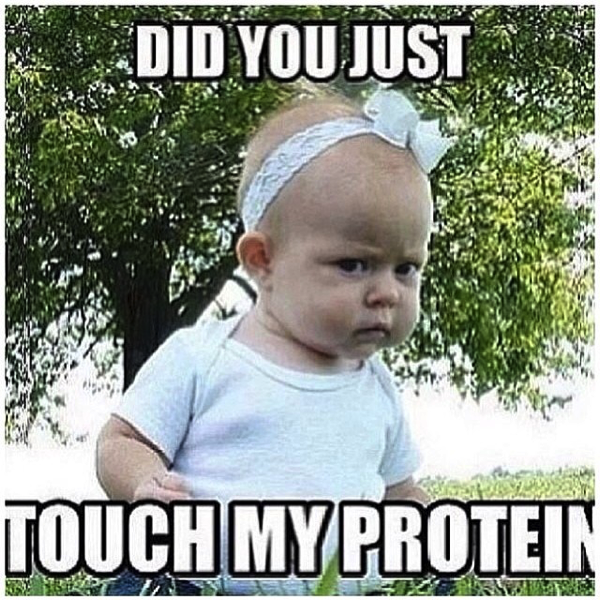BY: HEATHER DOLAN
Protein is trending, big time. A 2015 International Food and Information Council survey indicated that 54% of consumers are increasing their protein intake1, while a 2016 Nielsen survey found that 73% of Americans prioritize high protein food options2. We want more protein because it satisfies hunger, keeps us feeling full, and builds muscle. The Paleo, Ketogenic, Mediterranean, and other fad diets emphasize low-carb, high-protein choices as a means to achieve healthy weight loss. Unfortunately, the average American is still fuzzy on how much protein and what type(s) of protein are optimal to do so. Furthermore, some nutritionists contend that the Recommended Daily Allowance (RDA) for protein is too low, while others warn against over-consuming protein. So, is there a proper portion of protein?
The current RDA for protein, an essential macronutrient that builds and maintains body tissues, is 0.36 g per pound. In their report of the 2015 Protein Summit, nutrition scientists Nancy Rodriguez and Sharon Miller argue that the current RDA for protein isn’t sufficient enough to meet the needs of the human body. They recommend that Americans need to consume double the RDA, citing studies that correlate higher protein intake with healthy body weight, and maintenance of lean body mass and mobility with age3. Alternatively, some nutrition experts argue that Americans are actually eating double the RDA and believe this higher dosage is unnecessary. In an interview, Johns Hopkins’ Weight Management Center director, Dr. Lawrence J. Cheskin, stated that most Americans (even vegetarians and athletes) are getting more protein than they need4.

Now, there have been numerous scientific studies that have shown a high-protein diet can effect weight loss in the short-term. In one such study, 19 subjects were placed for 12 weeks on a high-protein diet without caloric restrictions and on average reduced their caloric intake by 440 calories and lost 11 pounds. In a much larger analysis, 1,063 individuals on a prescribed high-protein diet for between 3 and 21 weeks lost on average 1.8 pounds5. However, few studies have been done examining the long-term effects of a high-protein diet, and it’s possible that this diet shift can negatively alter metabolism in the long term. In a weight-loss study performed on obese, post-menopausal women, the group consuming normal levels of protein on a calorie-restricted diet showed increased insulin sensitivity, while the group on a high protein diet did not. This is an alarming outcome, because many overweight and obese people have poor insulin sensitivity, and are therefore much more susceptible to type 2 diabetes6.
With all of this conflicting information found in the literature, it can be easy to “freak out” about the dearth (or lack thereof) of protein in your current diet. Your best bet is to avoid focusing solely on protein intake and to take a more holistic approach to eating healthy. While protein is an essential dietary component, it’s also important to incorporate healthy fats and carbohydrates. A variety of other micronutrients, such as fiber, have been shown to have positive benefits7-9. High-protein foods rich in other nutrients include eggs, which contain 6 g of protein and 13 essential vitamins and minerals. A half cup of lentils provides 9 g of protein and 8 g of dietary fiber, while a 4 oz. serving of salmon contains 23 g protein, and is also chock-full of omega-3 fatty acids and vitamin B12. Protein bars and powders are a good alternative to whole foods when on-the-go, or can boost the protein content of already nutritious meals, such as oatmeal or a black bean burger.

http://how2getbig.com/proteins/
When selecting what foods to eat, it’s important to read labels and understand which macronutrients are predominantly represented. For example, Chobani Flips Clover Honey yogurt boasts 11 g of protein and 190 calories (sounds great, right?), but might not be worth the 29 g added sugar (over the 25 g RDA for women) listed in the nutrition facts.10
In conclusion, whether you’re all-in, lukewarm, or completely apathetic to the high-protein trend, double-check that your protein intake matches your lifestyle.

References
- International Food Information Council Foundation. 2015. The 2015 Food & Health Survey: customer attitudes toward food safety, nutrition & health. Available from: http://www.foodinsight.org/2015-food-health-survey-consumer-research. Accessed 2017 May 8.
- Nielsen. 2016. A healthy salute to New Year’s resolutions. Available from: http://www.nielsen.com/us/en/insights/news/2016/a-healthy-salute-to-new-years-resolutions.html. Accessed 2017 May 8.
- Rodriguez NR, Miller SL. 2015. Effective translation of current dietary guidance: understanding and communicating the concepts of minimal and optimal levels of dietary protein. Am J Clin Nutr 101:1353S–8S.
- Bloomberg Pursuits. 2016. Enough with the protein. Available from: https://www.bloomberg.com/news/articles/2016-11-04/enough-with-the-protein-america. Accessed 2017 May 10.
- Cuenca-Sánchez M, N-CD, Orenes-Piñero E. 2015. Controversies surrounding high-protein diet intake: satiating effect and kidney and bone health.Adv Nutr (Bethesda) 6(3):260-266.
- Smith GI, Yoshino J, Kelly SC, Reeds DN, Okunade A, Patterson BW, Klein S, Mittendorfer B. 2016. High-Protein intake during weight loss therapy eliminates the weight-loss-induced improvement in insulin action in obese postmenopausal women.Cell Rep 7(3):849-861.
- Andersson A, Bryngelsson S. 2007. Towards a healthy diet: from nutrition recommendations to dietary advice. Scand J Food Nutr 51(1): 31-40.
- Shenkin A. 2006. Micronutrients in health and disease. Postgrad Med J 82(971): 559-567.
- Fiber: Anderson JW, Baird P, Davis Jr RH, et al. 2009. Health benefits of dietary fiber.Nutr Rev 67(4):188-205.
- American Heart Association. 2017. Added Sugars.. Available from: http://www.heart.org/HEARTORG/HealthyLiving/HealthyEating/Nutrition/Added-Sugars_UCM_305858_Article.jsp#.WRNmnvnyuM8. Accessed 2017 May 10.
- National Academy of Sciences. 1989. Protein and amino acids. Recommended Dietary Allowances. 10th Edition. Washington D.C.: National Academies Press (US). p. 52-77.






Thank you for sharing your article with us. Indeed! Protein helps a lot to improve our health. Some other folks may not know about the importance of this, but mostly people taking protein is conscious of their diet, and those gym-goers. When I started to have a balanced diet, I keep on searching online to look for a food that I needed to eat to manage my weight loss plan, then I found this post that helps me a lot until now. Please check this out here https://nucific.com/nucific-diet/ perhaps it may help the other readers, thanks.